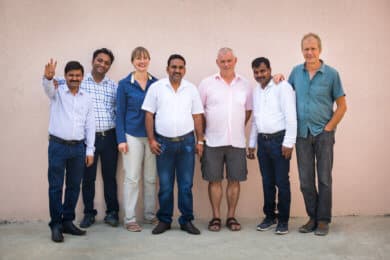
Honor Thy Label is available for order today!
EXCERPT: GROWTH AND DIVERSIFICATION AT PAVITRAMENTHE
Just like Dr. Bronner’s, Pavitramenthe is a business first and foremost. Unless it makes a profit, it won’t contribute effectively to our grand vision of using business to drive social and ecological change.
As a serial small-scale entrepreneur, Nihal Singh swiftly took to heart the principle that a business with a single customer—Dr. Bronner’s—and a single product—mint oil—is a bad idea. And so we started our diversification. Most Indians are vegetarians, and farmers in Uttar Pradesh grow a range of legumes: lentils, peas, beans, and peanuts. There are vegetables, such as carrots, cauliflower, onions, and okra. Spices include cumin, coriander, chili, and mustard seed. Herbs other than mint include holy basil and chamomile.
With its diverse and effective agricultural and fair trade programs, Pavitramenthe easily achieved Regenerative Organic Certification™ (ROC™) silver status in 2019, thus becoming the first supplier of a potentially wide range of ROC-certified field crops. A respected German organic brand wondered whether Pavitramenthe could supply peanuts; makers of herbal teas and supplements searched for a range of regeneratively grown herbs, such as holy basil, or tulsi, and an organic food company is interested in regenerative millet.

Meanwhile, Indian brands and consumers become interested in organic goods. With Pavitramenthe’s established credibility, Nihal has great opportunities to diversify locally. Our next steps for this increasingly complex project? Expand the number of farmers from the current 2,000 to 2,500 on 10,000 acres of land. Expand our regenerative program such that by 2025 some 90 percent of project farmers apply sufficient compost, practice conservation tillage, and grow cover crops. Each farmer may grow a mint crop every year, and the rest of the land will grow a diversity of crops—food crops for local consumption, as well as value-added organic and fair certified products for the high-end Indian and international markets.
With reduced cost of production, premium prices, improved soil fertility, and increased yields, farmers’ margins will increase and offer the next generation of villagers an attractive alternative to moving to the city, or at least a supplementary income. That’s our dream—and, we increasingly think it’s realistic.
Crop diversification is not the only way to grow and improve the project. Nihal had always dreamed of building his own central distillation plant, replacing tens of inefficient field distilleries and improving efficiency. Serendipity intervened and showed us the way to a modern, efficient, and safe central distillation plant at Pavitramenthe. In June 2018, the Special Ops team held its annual retreat in Provence, near Distillerie Bleu Provence, our supplier of lavender and lavandin oils.
The company’s founder, Philippe Soguel, showed us his distillation unit for aromatic herbs. It used the same concept and tank size as the field units in in Bareilly but was much more efficient. With Phillip’s permission I jotted down all relevant information: temperatures, volumes, energy flow, and took a few photos of the condenser—the cooling system for the mix of steam and essential oil vapor.

From Provence, Rob, Jenn, and I went straight to Bareilly. There, we took temperature profiles of several local distillation units, confirmed that condensate cooling was poor and wasteful, gave Nihal a few basic suggestions, and he listened.
For the 2019 season, he engineered and fabricated six distillation tanks that achieved similar performance to Phillipe’s: condensate temperatures of about 40° C, instead of 70° C, thus a 15 percent increase in oil yield by reducing volatilization losses, (benefiting the farmers), and much safer working conditions.
This miracle was informal technology transfer at its best. Philippe, who loves sharing his knowledge, was pleased with this “knock off,” and he and Nihal laughed hard about it when they first met at the 2020 Biofach.
Many such improvements to processing are rather physical. They require understanding of the process, a talented local fabricator, and the drive to test and improve. As a scientist, I like such basic improvements, not just because they lower the cost of production, but because they empower people to think for themselves and to make changes by rather nondigital means.
Mastering computers and digital communication is essential to running our projects, but eventually they all grow and process crops—and the rules for that haven’t changed enough that you couldn’t fix most things with rather basic knowledge-based methods.

That, of course, is one of the biggest lessons of our journey to organic and fair trade ingredients. In a sense we’ve all created “universities of coconut, palm, or mint oil”—not simply meeting our sourcing needs but helping to train people in building and operating a professional and responsible business.
Thanks to the resourcefulness of Nihal and his team, the project’s growth has continued even as India faced tremendous challenges during COVID. After a national lockdown put 4000 farm workers out of work in 2020, three rounds of emergency food relief were organized while workers waited for work to resume. As Dr. Bronner’s demand grew by 40%, so did Pavitramenthe’s output of mint oils—while at the same time new customers for “regenerative” medicinal herbs were found. This goes to show that building regenerative supply chains requires more than just improving soils; project operators also need to consider basic rules of capitalism, tend to customer needs, spot opportunities—always with more in mind than the financial bottom line.
